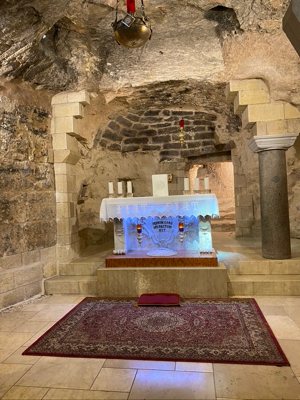
“Verbum caro factum est.”
If you’re not familiar with this Latin phrase, you likely know its English translation: “The Word became flesh.”
The phrase comes from John 1:14, but it’s threaded throughout the Church’s prayer. We say it when we pray the Angelus, and during the Church’s liturgy on Christmas and the feast of the Annunciation. It captures the heart of our faith, that God became man in the person of Jesus Christ.
But there is one place in the world where this phrase is altered. In one church, emblazoned on the altar, are the Latin words, “Verbum caro hic factum est.”
The addition of “hic” isn’t a typo. It’s intentional. “Hic,” in Latin, means “here.” “The Word became flesh here.”
The church is the Basilica of the Annunciation. It’s found in Nazareth, today a bustling Arab-majority city in the Northern District of the modern nation of Israel. But 2,000 years ago, it was the home of a young Jewish woman named Mary — and the site of the Incarnation.
(To be fair, there is a tradition that the Holy House of Loreto is the actual building in which the Annunciation took place, transported to Italy by angels in the Middle Ages. The words above its altar read “Hic Verbum caro factum est.” Either way, it all started in Nazareth.)
The impressive basilica, and the little “hic” upon its altar, witness not to a pious sentiment or to an abstract theory, but to a concrete historical fact. In this place, the infinite God of the universe entered time and space and took on our human nature. In this place, God became man, beginning his redemption of humanity by assuming it.
But the Basilica of the Annunciation is not a museum piece. It is not merely a reminder of something that happened in the remote past. Rather, affirming that Jesus became incarnate here, in Nazareth, 2,000 years ago, it allows us to affirm that he is present to us today, in the Archdiocese of St. Paul and Minneapolis.
Because when God entered time and space in the person of Jesus, it wasn’t simply to perform a task, and then to disappear; to become close, only to become beyond reach again. Rather, Christ came to establish his kingdom. The kingdom of his abiding presence and love. The kingdom of Emmanuel — God with us.
The same love and grace he poured forth from his crucified body is available to us today through his body, the Church, animated by his Holy Spirit. Christ comes to us most especially in the Eucharist and the other sacraments, and in prayer and in our belonging to the community of believers, which prolongs his personal presence.
And Christ comes to us in the rather ordinary and everyday facts of our lives, our relationships, our work, our leisure. This is, after all, how he first entered the world: not with pomp and circumstance, but through the womb of a teenage girl in the backwaters of ancient Israel.
This is why Servant of God Luigi Giussani — founder of the ecclesial movement Communion and Liberation — remarked after visiting the Nazareth grotto that it was as if he was “petrified by the sudden evidence of the method of God, who took something that was nothing, really nothing.”
This is the way that Christ continues to act and continues to make himself present to us. He hasn’t left us. Thus, when members of Communion and Liberation pray the Angelus, they respond to “the Word became flesh” not with “and dwelt among us,” but with “and dwells among us.”
Yes, Christ’s incarnation happened in a particular time and a particular place: Nazareth, about 2,000 years ago. But that event has stretched throughout history and reaches us today. We can only celebrate that it happened then, in Nazareth, by taking seriously how Jesus wants to enter our own lives, “hic” and now.
Liedl, a Twin Cities resident, is a senior editor of the National Catholic Register and a graduate student in theology at The St. Paul Seminary School of Divinity in St. Paul.




